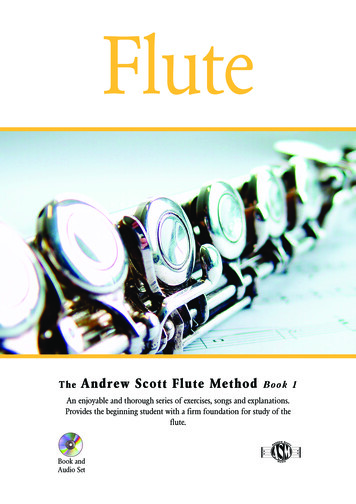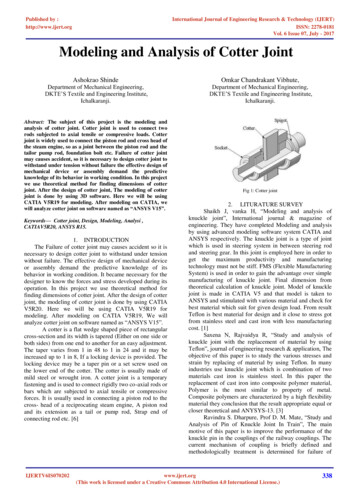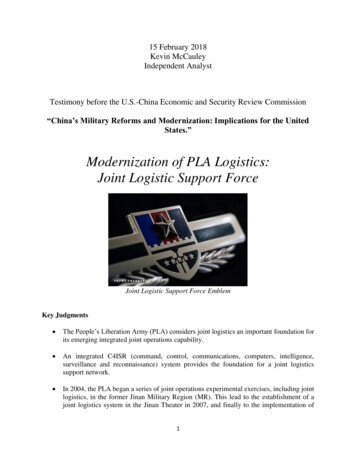
Transcription
Preparing for your First JointCommission SurveyStacy Olea, MBA, MT(ASCP), FACHEExecutive Director LaboratoryAccreditationApril 23, 2015
Objectives Describe The Joint Commission Laboratorysurvey process Explain Tracer Methodology Create mock tracers to use in yourorganization Identify the resources available to assist withsurvey preparation and continuouscompliance2
The Joint Commission3
The Joint Commission’s VisionAll people experience the safest, highest quality, bestvalue health care across all settings.The Joint Commission’s MissionTo continuously improve health care for the public, incollaboration with other stakeholders, by evaluatinghealth care organizations and inspiring them to excelin providing safe and effective care of the highestquality and value.4
What is unique to our surveyprocess? Employed surveyor cadre Concentration on the operationalsystems that directly affect the qualityand safety of diagnostic services National Patient Safety Goals Tracer Methodology Lab Central ConnectTM5
Employed Peer SurveyorCadre Requirements to be a Laboratory Surveyor– Bachelor’s Degree and certification– Master’s Degree– 5 years clinical laboratory management experience– Experience in 3 areas/specialties Surveyor training– Initial– Ongoing Life as a surveyor– Types of laboratories– Quantity of laboratories– Performance monitoring6
Operational SystemsApproach Our mission and vision drives us to look at how thelaboratory is integrated into patient care Standards consistent across all programs We will spend time outside of the laboratory– Nonwaived ancillary Point of Care Testing sites– A sampling of waived and PPMP Point of CareTesting sites– Hospital/Clinic Integration– Patient Medical Record– Infection Control– Human Resources7
National Patient Safety Goals NPSG.01.01.01 Two Patient Identifiers NPSG.02.03.01 Critical Results NPSG.07.01.07 Hand Hygiene8
Tracer Methodology Uses actual patients as the framework for assessing standardscompliance Individual tracers follow the experience of care through theentire health care process in the organization System tracers evaluate the integration of related processes– Coordination and communication among disciplines anddepartments– In-depth discussion and education regarding the use of datain performance improvement Reference document available athttp://www.jointcommission.org/tracer methodology 101/9
Lab Central ConnectTM Nonwaived CLIAs only Personnel for each CLIA:– Laboratory Director– Technical Consultant (moderate complexity)– Technical Supervisor (high complexity)– General Supervisor (high complexity)– Clinical Consultant (moderate and high) Test Systems for each CLIA Are you accepting outside specimens for testing? Cytology– Workload for all personnel performing primary screening– Annual statistics10
Joint Commission SurveyOptions Anatomical Pathologist Corporate Surveys– Dedicated Team– Orientation to your Organization– Annual Summation Simultaneous Surveys– Other Programs– Sister facilities Concurrent Surveys11
E-App Required upon initial application for survey and verifyinformation annually Included information: ownership, demographics, types andvolumes of services provided Drives the anticipated number of survey days, number and typeof surveyors, and survey agenda activities Inaccurate or incomplete information may necessitate anadditional survey and cause the organization to incur additionalsurvey charges Description for calculating non-waived volumes athttp://www.jointcommission.org/Guidelines for Counting Testsfor CLIA/12
Required Documentation Documentation list for your survey– The 24 month reference in the followingitems is not applicable to initial surveys,except for proficiency testing data.– For initial surveys, a minimum of 4 monthsof data must be available for review.13
Required Documentation As a laboratory, you should have the following information anddocuments available for the surveyor to review during theSurveyor Planning Session– Name of key contact person who can assist in planning tracerselections– CLIA Certificates, Specialties and Subspecialties, State Licenses,and personnel license or certification if required by the state ororganization policy– An organizational chart and map of the facility– Ability to retrieve testing records for patients who have hadlaboratory tests or other services for the past 24 months (4 monthsif an initial survey)– Performance improvement Data for the past 24 months (4 monthsif an initial survey)– Proficiency Testing data by CLIA number for the past 24 months14
Required Documentation As a laboratory, you should have the following information anddocuments available for the surveyor to review during theSurveyor Planning Session– Results of periodic laboratory environment inspections from the safetycommittee or safety officer– Manifests for the disposal of hazardous waste for the past 24 months (4months if an initial survey)– A list of specialties and subspecialties performed by the lab– A list of tests performed (test menu) and instruments used including allancillary and point of care sites– Measures of Success (MOS) identified in the Plan of Action from thePeriodic Performance Review– Employee personnel files will be reviewed, including employee educationrecords, competency documentation, and employee health information– Note: Surveyors may need to see additional documents throughout thesurvey to further explore or validate observations or discussions with staff.15
On-Site Survey Activities Surveyor photo, bio and survey agenda are posted to theextranet site at 07:30 local time Depending on the complexity of the organization a surveymay last more than one day and could involve a team ofsurveyors Once the surveyor arrives, the organization’s extranetmust be checked for confirmation of the survey andidentification of the surveyor Preliminary Planning Session Opening Conference Orientation to the Organization16
On-Site Survey Activities A Daily Briefing occurs every morning of a multidaysurvey, with the exception of the first day Competency Assessment Personnel education/qualification verification Regulatory Review Proficiency Testing Validation/Performance ImprovementData Review Individual Tracers (60% of survey activity) Physical Environment Survey Report Preparation CEO Exit Briefing and Organization Exit Conference17
From Survey Report toAccreditation Decision A preliminary report is available on the extranet until midnightof the day the survey has been completed. The accreditation decision is not made until all of yourorganization’s post-survey activities are completed The final summary of survey findings report will be posted onyour extranet site.– It will include which findings require an Evidence ofStandards Compliance (ESC) submission within 45 days(direct impact standards) and/or 60 days (indirect impactstandards) Upon approval of your organization’s last submitted ESC, youraccreditation decision is posted to your extranet site and toQuality Check (www.qualitycheck.org)18
Corrective ESC An acceptable corrective ESC report must detail the following:– Action(s) that the organization took to bring itself into compliancewith a standard– The title of the person(s) responsible for implementing thecorrective actions or approving a revised policy, procedure, orprocess– Compliance at the EP level and include a Measure of Success(MOS) if applicable Measure of Success (MOS)– A numerical or quantifiable measure, usually related to an audit todetermine if action was effective and sustained– Due four months after notification of an acceptable ESC– Not required for all ESCs19
From Accreditation to ContinuousCompliance with the Standards Concentrate on incorporating the frameworks andconcepts of standards and EPs into day-to-day workrather than viewing the concepts as rules that mustbe followed Read Perspectives each month to identifynew/updated standards, scoring, standardsinterpretation Sign up for E-Alerts Keep Lab Central ConnectTM updated Complete your Intracycle Monitoring Contact SIG to submit standard questions20
Tracer Methodology21
Before Tracers Records review No link to patientcare22
Tracer Methodology Surveyors evaluate the following:– Compliance with standards and National Patient SafetyGoals– Consistent adherence to policy and consistentimplementation of procedures– Communication within and betweendepartments/programs/services– Staff competency for assignments and workload capacity– Personnel requirements– The physical environment as it relates to the safety ofpatients, visitors, and staff23
Tracer Methodology Patients are the framework Follows the experience of care Begins with a test result Includes preanalytics and postanalytics Involves multiple staff, the patient, and even familyto learn details about an individual’s health careexperience Specialties and subspecialties for a 2 year period– 13 – 24 months– 6 – 12 months– Within the last 6 months24
Starting Points Common starting pointsfor tracers– Patients who cross settings– Critical results– Point of care testinglocations– Direct observations– Proficiency Testing results– Abnormal results– Kit testing– Tests that use e-QC25
Documents Reviewed Documents reviewed– Instrument maintenancerecords, calibrationverification, qualitycontrol, correlations– Policies and procedures– Employee competencyand qualifications– Process improvement– Patient medical records– Waste disposal records26
Interview laboratory StaffAbout Processes andcompliance withstandards Intradepartment andinterdepartmentcommunication Address data use Processes and roles tominimize risk National Patient SafetyGoals Orientation, trainingand competency Awareness ofAPR.09.02.01 Workload issues Validation ofinformation learned27
Interview Others About Physicians/Nursing Staff Inquire if laboratoryservices/tests offeredonsite are adequate Communication andcoordination when newtests are added and whentest reports change Ascertain what iscommunicated and bywhat methodPatients and Family Coordination of servicesincluding timeliness Education provided Perception of services Understanding ofdischarge instructionsfollowing an outpatienttransfusion Staff compliance withNPSGs28
Completing the TracerObserve Potential environmentalissues Sample collection Transfusion POCT Infection controlprocesses ProcessImprovementAfterwards Review meeting minutes Review procedures Pull additional records ifnecessary29
Chemistry, Hematology, &Coagulation Quality Control Maintenance records E-QC Policy and Procedures Calibration andCalibration Verification Lot numbers in use Correlations Validation of newinstruments/methods Surveillance of patientresults, quality controlresults, and instrumentpreventative maintenance Documentation oftemperatures Environment of Care Patient medical record Coagulation: ISI andNormal Patient Mean NPSGs30
Serology, Virology,Immunology, Molecular andUA Quality Control Maintenance Temperatures Lot numbers Patient medical record Validation of new methods and instruments Surveillance of patient results, quality control results, andinstrument preventative maintenance Environment of Care NPSGs31
Waived Testing Outside thelaboratory Patient medical record quality control (internal and external) Reference Ranges Lot numbers NPSGs Environment of Care Policy and Procedures Maintenance Temperatures32
Patient Medical Record Order for the test Reference Ranges Name and address of the performing laboratory Consents Order to transfuse Preliminary Reports Intra-operative Reports Documentation for critical results Final report for transfusion reactions Tissue record documentation33
Employee File Documentation of Education (diploma or transcript) Documentation of experience State license if required CLIA required roles qualifications Orientation If a new employee, 6 month competency assessment fornonwaived testing Nonwaived annual competency Waived annual competency Training (Blood Administration Training) Flu vaccine34
Mock Tracers35
Purpose Evaluate the effectiveness of policiesand procedures Engage staff in looking for opportunitiesto improve processes To be certain compliance issues havebeen addressed36
Skill set for Mock TracersAsk Good Questions Simple questions insuccession Encourages staff to shareinformation Use observations of thesurrounding Use responsesAnalysis and Organize Plan a mock tracer Report results Follow up37
Mock Tracer Checklist and Timeline Planning and Preparing for the Mock TracerStep 1: Establish a schedule for the mock tracerMonth 1Step 2: Determine the scope of the mock tracerMonth 1Step 3: Choose those playing the roles of surveyorsMonth 1Step 4: Train those playing the roles of surveyors Months 1 and 2Conducting and Evaluating the Mock TracerStep 5: Assign the mock tracerMonth 2Step 6: Conduct the mock tracerMonth 3Step 7: Debrief about the mock tracer processMonth 3Analyzing and Reporting the Results of the Mock TracerStep 8: Organize and analyze the results of the mock tracerMonth 4Step 9: Report the results of the mock tracerMonth 4Applying the Results of the Mock TracerStep 10: Develop and implement improvement plans38Months 5 - 7
Tracer Team Member(s):Tracer Topic:Data Record(s):Unit(s) or Department(s):Interview Subject: Emergency Department ManagerCorrect Incorrect Follow-up CommentsQuestions[1] Please provide the patient’s medical record for review.[2] How are physicians informed that a stat result has been transmitted tothe emergency department?[3] Are those results visible to patients and other non-staff ?Interview Subject: Laboratory SupervisorCorrect Incorrect Follow-up CommentsQuestions[4] What is your typical turnaround time for emergency departmentlaboratory results?[5] Have you considered the time from specimen collection to receipt inthe laboratory, and the time from results to communication of the result tothe physician?[6] May I see the procedures, proficiency test results, quality control,calibration, calibration verification, and maintenance and temperaturerecords for the automated chemistry and hematology analyzers?[7] Please provide the quality control records for the pregnancy test thatwas performed on the patient.Interview Subject: Human Resources ManagerQuestions[8] Please provide the competency and education records for the staffperforming these laboratory tests.Correct Incorrect Follow-up Comments39
Tips for Conducting Tracers ina Laboratory Setting Use closed records Focus on issues of particular concern Include tracers that cover the two year timeframe For laboratories that are part of a hospital, considerthe issues related to laboratory integration Evaluate the inclusion of laboratory personnel in keycommittees such as infection prevention and control Select a patient who received multiple laboratorytests40
41
Examples of Questions What processes and procedures doyou have in relation to POCT? What oversight responsibility doesthe laboratory have in relation toPOCT? What process exists for STATtests? How are results communicated? How do you receive an order forPOCT? How do you ensure correct patientidentification before drawing asample? What is your hand washing policy? What kind of training andcompetency do you provide for staffmembers who conduct POCT? What methods do you use toassess competency forwaived/nonwaived/PPMP testing? Will you show me the temp logs foryour storage refrigerators? What is the process for testing thatcannot be completed onsite? What communication processes doyou have in place for receiving andreporting critical results?42
Examples of Questions How do you ensure the privacy oftest results? What documentation do you havein relation to instrumentmaintenance? What kind of documentation do youmaintain for quality control,calibration, calibration verification,and correlations? What routine documentation do youhave in place in the laboratory?How do you monitor forcompleteness? What kind of monitoring do you dowith regard to waived testing andhow is that documented? How do you document testing?43
Resources and Tools44
Resources for Tracers Survey Activity Guide (SAG) Tracer Methodology 101 The laboratory Tracerwww.jointcommission.org Tracer Worksheet for your Mock Form LaboratoryTracer.doc. Publications from JCR– Tracer Methodology– More Tracers45
46
47
www.jointcommission.org48
The Extranet Perspectives Leading PracticeLibrary– Sort by program,chapter BoosterPaks– Waived Testing– Sample Collection E-dition– Sort by chapter,specialty– Print, save, or email Lab CentralConnect– Education modules– Links to resources IQCP PowerPoint49
50
51
52
Preparation Tips Account Executives– Primary contact between The Joint Commission and the organization– Responsible for coordinating the survey planning and handles policies,procedures, accreditation issues or services and inquiries throughout theaccreditation cycle– On initial surveys, will be assigned after the e-App has been submitted Standards Interpretation Group– Dedicated laboratorians (70 years lab experience)– Same resource that the surveyors use– Responsible for clarification of standards– Phone at 630-792-5900 Option 6, 8:30 a.m. - 5:00 p.m. CT– Online question form gsubmissionform.aspx– FAQs online athttp://www.jointcommission.org/standards information/jcfaq.aspx53
Preparation Tips Required Written Documentation (RWD) section of theCAMLAB– List of elements of performance that require writtendocumentation– It is meant to be a guide in preparing for the survey– Written documentation includes policy, procedure, plan,CLIA certificate, license, evidence of testing, documentationof reviews by supervisors and directors, data, lists,performance improvement reports, specimen identificationand labels, MSDS, and meeting minutes– The primary emphasis will be on how your laboratorycarries out the functions described in the CAMLAB. Thedocumentation review will be used along with interviewsand visits to the patient care setting54
Preparation Tips Perform Mock Tracers– Focus on issues of particular concern for laboratories andprocess interfaces with clinical staff.– Consider your laboratory’s past testing activity as a startingpoint– Select the medical record of a patient who received multiplelaboratory tests, including tests performed at point of caresites– Instead of one person conducting the tracer, considerwalking through one as a group– Don’t forget to consider the beginning and end of a process,not just the outcome55
56
Top Non-ComplianceStandards 2010 - 201480706050403020100QSA.01.01.01PT CalibrationVerification20112012DC.02.03.01Lab Correlations201457
Top Non-ComplianceStandards 2010 - tQSA.01.03.01PT Handling &Testing2010QSA.01.02.01PT 02.04.01e-QCHR.01.02.05StaffQualifications201458
59
QuestionsStacy Olea, MBA, MT(ASCP), FACHEExecutive Director Laboratory 60
Describe The Joint Commission Laboratory survey process Explain Tracer Methodology Create mock tracers to use in your organization Identify the resources available to assist with survey preparation and continuous compliance . 3 The Joint Commission . 4 .











